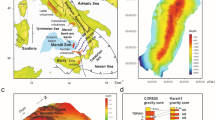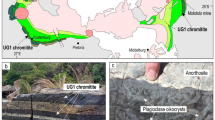Abstract
Many submarine caldera volcanoes are blanketed with deposits of highly vesicular pumice, typically attributed to vigorous explosive activity1,2,3,4. However, it is challenging to relate volcanic products to specific eruptive styles in submarine volcanism5,6. Here we document vesicularity and textural characteristics of pumice clasts dredged from the submarine Macauley volcano in the Kermadec arc, southwest Pacific Ocean. We find that clasts show a bimodal distribution, with corresponding differences in vesicle abundances and shapes. Specifically, we find a sharp mode at 91% vesicularity and a broad mode at 65–80%. Subordinate clasts show gradients in vesicularity. We attribute the bimodality to a previously undocumented eruptive style that is neither effusive nor explosive. The eruption rate is insufficient to cause magma to fragment explosively, yet too high to passively feed a lava dome. Instead, the magma foam buoyantly detaches at the vent and rises as discrete magma parcels, or blebs, while continuing to vesiculate internally. The blebs are widely distributed by ocean currents before they disintegrate or become waterlogged. This disintegration creates individual clasts from interior and rim fragments, yielding the bimodal vesicularity characteristics. We conclude that the generation and widespread dispersal of highly vesicular pumice in the marine environment does not require highly explosive activity.
This is a preview of subscription content, access via your institution
Access options
Subscribe to this journal
Receive 12 print issues and online access
$259.00 per year
only $21.58 per issue
Buy this article
- Purchase on Springer Link
- Instant access to full article PDF
Prices may be subject to local taxes which are calculated during checkout




Similar content being viewed by others
References
Allen, S. R. & McPhie, J. Products of neptunian eruptions. Geology 37, 639–642 (2009).
Fiske, R. S., Naka, J., Iizasa, K., Yuasa, M. & Klaus, A. Submarine silicic caldera at the front of the Izu-Bonin arc, Japan: Voluminous seafloor eruptions of rhyolite pumice. Geol. Soc. Am. Bull. 113, 813–824 (2001).
Fiske, R. S., Cashman, K. V., Shibata, A. & Watanabe, K. Tephra dispersal from Myojinsho, Japan, during its shallow submarine eruption of 1952–1953. Bull. Volcanol. 59, 262–275 (1998).
Kano, K. Subaqueous pumice eruptions and their products: A review. Geophys. Monogr. AGU 140, 213–229 (2003).
Arculus, R. Submarine volcanism: Deeply explosive. Nature Geosci. 4, 737–738 (2011).
Sigurdsson, H. et al. (eds) in Encyclopedia of Volcanoes 1–1417 (Academic, 2000).
Allen, S. R., Fiske, R. S. & Tamura, Y. Effects of water depth on pumice formation in submarine domes at Sumisu, Izu-Bonin arc, western Pacific. Geology 38, 391–394 (2010).
Houghton, B. F. & Wilson, C. J. N. A vesicularity index for pyroclastic deposits. Bull. Volcanol. 51, 451–462 (1989).
Klug, C., Cashman, K. V. & Bacon, C. R. Structure and physical characteristics of pumice from the climactic eruption of Mount Mazama (Crater Lake), Oregon. Bull. Volcanol. 64, 486–501 (2002).
Houghton, B. F. et al. Diverse patterns of ascent, degassing, and eruption of rhyolite magma during the 1.8 ka Taupo eruption, New Zealand: Evidence from clast vesicularity. J. Volcanol. Geotherm. Res. 195, 31–47 (2010).
Spieler, O. et al. The fragmentation threshold of pyroclastic rocks. Earth Planet. Sci. Lett. 226, 139–148 (2004).
Sparks, R. S. J. The dynamics of bubble formation and growth in magmas: a review and analysis. J. Volcanol. Geotherm. Res. 3, 1–37 (1978).
Blundy, J. & Cashman, K. V. Rapid decompression-driven crystallization recorded by melt inclusions from Mount St. Helens volcano. Geology 33, 793–796 (2005).
Wright, H. M. N., Cashman, K. V., Rosi, M. & Cioni, R. Breadcrust bombs as indicators of Vulcanian eruption dynamics at Guagua Pichincha volcano, Ecuador. Bull. Volcanol. 69, 281–300 (2007).
Shea, T. et al. Textural studies of vesicles in volcanic rocks: An integrated methodology. J. Volcanol. Geotherm. Res. 190, 271–289 (2010).
Lloyd, E. F., Nathan, S., Smith, I. E. M. & Stewart, R.B. Volcanic history of Macauley Island, Kermadec Ridge, New Zealand. N.Z. J. Geol. Geophys. 39, 295–308 (1996).
Barker, S. J., Rotella, M. D., Wilson, C. J. N., Wright, I. C. & Wysoczanski, R. J. Contrasting pyroclast density spectra from subaerial and submarine silicic eruptions in the Kermadec arc: Implications for eruptive processes and dredge sampling. Bull. Volcanol. 74, 1425–1443 (2012).
Smith, I. E. M., Stewart, R. B. & Price, R. C. The petrology of a large intra-oceanic silicic eruption: The Sandy Bay Tephra, Kermadec Arc, Southwest Pacific. J. Volcanol. Geotherm. Res. 124, 173–194 (2003).
Barker, S. J. et al. Geochemistry and petrogenesis of silicic magmas in the intra-oceanic Kermadec arc. J. Petrol. 54 http://dx.doi.org/10.1093/petrology/egs071 (2012).
Cashman, K. V., Sturtevant, B., Papale, P. & Navon, O. Encyclopedia of Volcanoes 421–430 (Academic, 2000).
Mueller, S. et al. The porosity of pyroclasts as an indicator of volcanic explosivity. J. Volcanol. Geotherm. Res. 203, 168–174 (2011).
Stern, R. J. et al. Evolution of West Rota Volcano, an extinct submarine volcano in the southern Mariana Arc: Evidence from seafloor morphology, remotely operated vehicle observations and 40Ar–39Ar geochronological studies. Isl. Arc. 17, 70–89 (2008).
Kokelaar, P. Magma-water interactions in subaqueous and emergent basaltic volcanism. Bull. Volcanol. 48, 275–289 (1986).
Rust, A. C. & Cashman, K. V. Permeability controls on expansion and size distributions of pyroclasts. J. Geophys. Res. 116, B11202 (2011).
Mann, C. P., Stix, J., Vallance, J. W. & Richer, M. Subaqueous intracaldera volcanism, Ilopango caldera, El Salvador, Central America. Geol. Soc. Am. Spec. Pap. 375, 159–174 (2004).
Siebe, C. et al. Submarine eruption near Socorro Island, Mexico: Geochemistry and scanning electron microscopy studies of floating scoria and reticulite. J. Volcanol. Geotherm. Res. 68, 239–271 (1995).
Gaspar, J. L. et al. Basaltic lava balloons produced during the 1998–2001 Serreta submarine ridge eruption (Azores). Geophys. Monogr. AGU 140, 205–212 (2003).
Kueppers, U. et al. Lava balloons—peculiar products of basaltic submarine eruptions. Bull. Volcanol. 74, 1379–1393 (2012).
Sahagian, D. L. & Proussevitch, A. A. 3D particle size distributions from 2D observations: Stereology for natural applications. J. Volcanol. Geotherm. Res. 84, 173–196 (1998).
Acknowledgements
We thank the Master and crew of the R/V Tangaroa for logistics on the TAN0706 voyage, and the Royal Society of New Zealand Marsden Fund (VUW0613) for financial support. S. Allen, R. Carey, J. McPhie, B. Houghton, R. Wysoczanski and J. White contributed advice, discussions and comments at various stages of this study. We would like to thank L. Gurioli, H. Wright and U. Kueppers for their helpful reviews.
Author information
Authors and Affiliations
Contributions
M.D.R. conceived the model and undertook imagery collection and vesicle textural analysis and interpretation. S.J.B. did the density determinations and assisted with figure design. C.J.N.W. and I.C.W. organized the voyage and collected samples with M.D.R. All authors contributed to writing the manuscript.
Corresponding author
Ethics declarations
Competing interests
The authors declare no competing financial interests.
Supplementary information
Supplementary Information
Supplementary Information (PDF 4448 kb)
Rights and permissions
About this article
Cite this article
Rotella, M., Wilson, C., Barker, S. et al. Highly vesicular pumice generated by buoyant detachment of magma in subaqueous volcanism. Nature Geosci 6, 129–132 (2013). https://doi.org/10.1038/ngeo1709
Received:
Accepted:
Published:
Issue Date:
DOI: https://doi.org/10.1038/ngeo1709
This article is cited by
-
Submarine terraced deposits linked to periodic collapse of caldera-forming eruption columns
Nature Geoscience (2023)
-
Dynamics of deep-submarine volcanic eruptions
Scientific Reports (2022)
-
Sediment waves and the gravitational stability of volcanic jets
Bulletin of Volcanology (2021)
-
Deep sea explosive eruptions may be not so different from subaerial eruptions
Scientific Reports (2020)
-
Submarine giant pumice: a window into the shallow conduit dynamics of a recent silicic eruption
Bulletin of Volcanology (2019)



